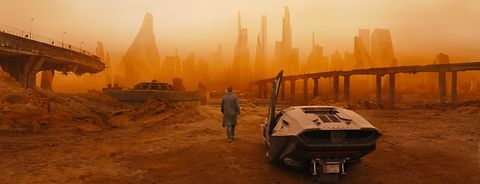Director Denis Villeneuve’s sequel to Ridley Scott’s 1982 classic brings back Harrison Ford as Rick Deckard, teaming him with Ryan Gosling as a replicant named K, and Jared Leto as the villainous Niander Wallace. Cinematographer Roger Deakins CBE, ASC, BSC worked with ALEXA XT Studio cameras, Master Prime lenses and ARRI lights to craft the film’s stunning visuals. Deakins’ gaffer, Bill O’Leary, spoke to ARRI Rental about how some of the complex lighting setups were achieved during the shoot in Hungary.
How would you describe the overall look of the film?
I would say that the look is quite naturalistic, in the sense that our approach was to use motivated light sources. It took some imagination on the part of Roger Deakins to take a leap into the future and decide what some of those sources would be. Concept art and the script also provided a lot of the references.
Can you describe the scale of the production and the prep time required?
I had nine weeks of prep time for a shooting schedule of around 90 days. We often had up to six stages working at Origo Studios and three at Korda Studios, in various stages of rigging, shooting and de-rigging. In total we had a lighting crew of around 20. They were without doubt the best crew I’ve worked with, apart from my regular New York crew, who I’ve been with for decades. Having such a top-notch rigging crew and top-notch programmers meant that dimming control was not at all difficult, despite the huge lighting package.

Lighting "Blade Runner 2049"
Gaffer Bill O’Leary describes the lighting approach on "Blade Runner 2049," which was supplied with a full camera, grip, and lighting package by ARRI Rental.







